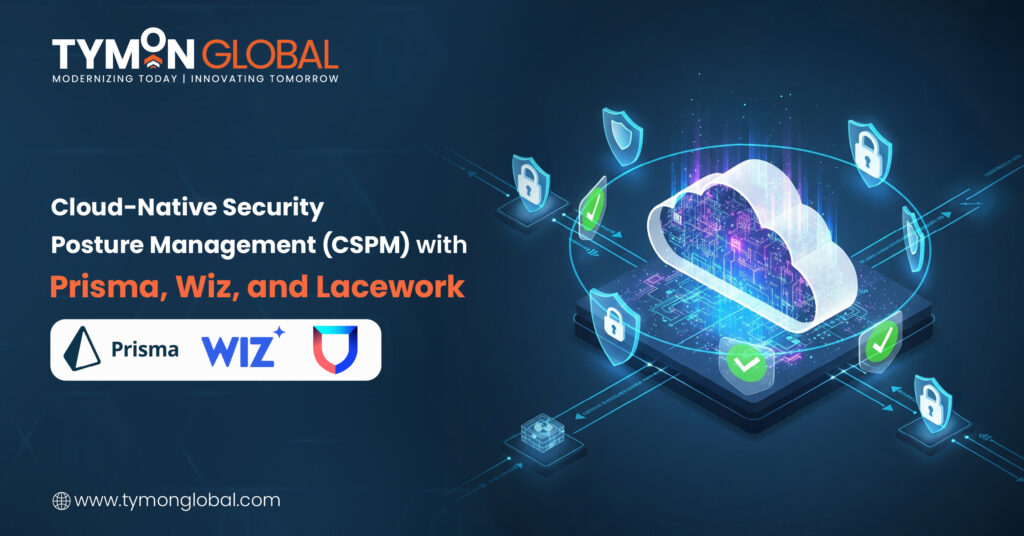
Cloud-native data engineering pipelines run at terabyte-to-petabyte scale across dispersed, containerised, and federated systems, expanding the operational attack surface beyond perimeter-level controls and IAM regulations. Infrastructure becomes code, and security must react dynamically. Cloud Security Posture Management (CSPM) becomes mission-critical as a native, real-time data engineering stack component.
MarketsandMarkets estimates that microservices, container orchestration with 78% production adoption of Kubernetes, and cloud-native data platforms like AWS Glue, Databricks, Google BigQuery, and Snowflake will grow the CSPM sector to $10.3B by 2025 at a 14.5% CAGR. Configuration drift, over-privileged identities, unscanned IaC, and lack of asset visibility have turned enterprise data pipelines into ungoverned surface areas, directly threatening compliance, privacy, and uptime SLAs.
This article presents a comparative technical evaluation of three leading CSPM platforms, Prisma Cloud (Palo Alto Networks), Wiz, and Lacework CSPM, through the lens of modern data engineering architectures, backed by hard metrics, design analysis, and production-scale threat modeling with top cloud service providers.
What is Cloud Security Posture Management (CSPM)?
Cloud Security Posture Management (CSPM) is a group of tools and methods used to monitor, evaluate, and correct cloud infrastructure security and compliance. CSPM solutions find mistakes, policy violations, and security holes in cloud resources such as storage buckets, IAM roles, Kubernetes clusters, and Infrastructure-as-Code deployments in dynamic, multi-cloud settings. This lowers risk in real time and makes sure that regulations are followed.
Security Complexity in Cloud-Native Data Engineering
Traditional ETL pipelines are no longer the only option for modern data engineering. It works in dynamic, networked cloud-native environments with declarative, API-driven, and configuration-prone storage and orchestration components. Data pipelines increasingly use streaming data stores, federated infrastructure across multi-cloud deployments, and ephemeral compute layers for real-time input, transformation, and machine learning.
These environments introduce an intricate web of threat vectors. The velocity at which DevOps teams deploy services using Infrastructure-as-Code (IaC) introduces both agility and risk. One malformed Terraform module can inadvertently make an S3 bucket containing sensitive customer PII globally accessible. Similarly, a Snowflake role misconfigured via inheritance may expose administrative privileges beyond intended scopes. In another instance, a Helm chart deploying into GKE could provision an overly permissive ServiceAccount that bridges access to Google Cloud Storage buckets, escalating internal permissions to external data leak paths.
These are not theoretical vulnerabilities. According to the IBM X-Force Cloud Threat Intelligence Report (Q2 2025):
- Misconfigured Infrastructure-as-Code caused 42% of cloud data breaches.
- These events had a median MTTD of 67 days due to a lack of real-time configuration drift monitoring.
- Each incident affected over 12% of cloud assets (median blast radius).
Key Threat Vectors in Modern Data Engineering:
- Ephemeral Compute Orchestration: Google Dataproc, Amazon ECS, and Kubernetes use dynamic, short-lived compute nodes. Privilege containers may connect to unapproved storage tiers or break isolation without real-time policy enforcement..
- Layered Storage Complexity: Pipelines now work with Kafka, Delta Lake, and S3. Different access requirements might cause shadow replication, data leakage, or inadvertent data persistence if not aligned.
- Federated Service Meshes: Cross-cluster and cross-cloud service meshes like Istio and Linkerd hide access control barriers with inter-service communication channels, making lateral movement attacks difficult to detect.
- CI/CD Pipelines with IaC: With Terraform, Pulumi, Helm, and CloudFormation driving deployments, configuration drift, IAM over-privileging, and policy misalignment are among the top root causes of data exposure.
Why This Requires a New Security Paradigm
These complexities necessitate more than after-the-fact security audits or isolated policy checklists. They require real-time, continuous, declarative security enforcement embedded directly into the DevOps toolchain. This is exactly what Cloud Security Posture Management (CSPM) platforms are built to solve. CSPM tools like monitor, visualize, and remediate security drift as it happens, not after a breach occurs.
Security posture must now be treated not as a one-time certification, but as a living system state that evolves with every deployment, merge, or scaling operation. In high-velocity data engineering environments, security must be codified, observable, and enforceable, or it’s already obsolete. As Tymon Global clients know firsthand, in data-driven infrastructure, speed without security is just a faster route to failure.
CSPM Evaluation Framework for Data Engineering
To evaluate Prisma, Wiz, and Lacework software, we apply a 6-dimensional matrix designed for high-throughput, enterprise-grade data infrastructures.
Dimension |
Relevance in Data Engineering |
|
Declarative Compliance |
Auto-map Terraform, Helm, and CloudFormation against NIST, PCI-DSS, HIPAA, and GDPR. |
|
Service Contextualization |
Enrich resource graphs with lineage from IAM to data layer; link misconfigs to data sensitivity. |
|
Runtime Enforcement |
Behavioral inspection of Spark, Beam, Flink, and containerized DAGs in execution. |
|
Asset Graph Mapping |
Visual mapping of asset interrelations: S3 <-> Lambda <-> Secrets <-> API Gateway. |
|
Temporal Drift Detection |
Detect config changes that break compliance over time; rollback automation. |
|
Lateral Movement Prevention |
Identify privilege escalations and unintentional access propagation across cloud accounts. |
Deep Technical Analysis: Prisma vs Wiz vs Lacework
Here’s a detailed side-by-side technical comparison of the top CSPM platforms, specifically from the viewpoint of cloud-native data infrastructure and enterprise DevSecOps.
Capability |
Prisma Cloud |
Wiz |
Lacework |
|
IaC Misconfig Detection |
Deep CI/CD integration, Terraform/Helm security policies | Agentless IaC scanning; integrates with SCM for shift-left enforcement | Basic IaC parsing, less granular control logic |
|
Data Exposure Risk |
Auto-tags S3, RDS, Big Query with sensitivity & exposure classification | Excellent mclassification with DSPM + exposure graphs | Limited focuses on behavior, not data semantics |
|
Runtime Anomaly Detection |
Correlates runtime with known policy breaches | Behavior graph detects policy + execution anomalies. | Strongest behavioral modeling engine (UEBA + container lineage) |
|
Policy-as-Code (OPA/Rego) |
Native support with Rego; customizable security controls | Deep Rego integration supports Open Policy Agent natively | Not core; some custom scripting required |
|
Multi-Cloud Awareness |
Full AWS, Azure, GCP, OCI integration; hybrid with on-prem | Full CSP support with unified graph | Strong AWS/GCP; Azure emerging |
|
API Rate Control/Drift Guard |
Monitors API throttling and unusual mutations | Tracks IAM changes and privilege escalations over time | Temporal state analytics; flagging drift from golden baseline |
|
Compliance Mapping (NIST, GDPR) |
>20 framework templates; audit-ready reporting | Automated real-time compliance with snapshot verification | Slower mapping; runtime-focused |
|
Data Engineering Integration |
Supports Kafka, Spark, Delta, and Glue metadata scanning | Data source-aware; integrates with Redshift, Snowflake, GCS | Focuses on workloads, not metadata-driven pipelines |
|
Best Use Case |
High-scale enterprises with hybrid infra & SOC/XDR need | Security-first teams managing compliance across high-velocity workloads | DevSecOps teams in Kubernetes-heavy environments with complex behaviors |
Why This Matters for Tymon Global Clients
As a Top Cloud Data Services USA, Tymon Global doesn’t think about cloud security compliance automation after the fact. We build security into the engineering process for each customer moving from old ERP monoliths to cloud-native, microservices-based data architectures. This is because compliance, privacy, and resilience must be part of the engineering process when working with high-velocity data. Our clients depend on data systems that must maintain the integrity of sensitive assets while being flexible, scalable, and audit-ready, especially in highly regulated sectors like healthcare, banking, and transportation.
To meet these needs, we build cloud-native security posture management into the DNA of the infrastructure. This means:
- Policy-as-code enforcement in CI/CD pipelines, where OPA evaluates Terraform, Helm, and Kubernetes manifests before deployment.
- Automated data exposure scanning on S3, Azure Blob, Google Cloud Storage, Snowflake, and Delta Lake, monitoring encryption, access misconfigurations, and compliance violations.
- Applying graph-based attack path analysis, leveraging tools like Wiz’s Security Graph, Prisma Cloud Asset Explorer, and Lacework Polygraph, which map out real-time access paths from compute nodes to sensitive data stores, so that invisible risks become visible and actionable.
In high-risk, multi-cloud environments, a misconfigured data bucket or privilege escalation isn’t just a code bug, it’s a multi-million-dollar breach waiting to happen. According to the IBM Cloud Threat Intelligence Report (2025), misconfigured IAM and cloud storage permissions contributed over $6.7 billion in direct remediation and compliance costs in the past year alone.
Tymon Global architected CSPM frameworks using Prisma Cloud for enterprise-wide coverage, Wiz for rapid data sensitivity detection and compliance automation, and Lacework for deep behavioral analysis in runtime environments all aligned to the specific cloud environments, regulatory landscapes, and operational priorities of our clients.
We don’t just secure infrastructure, we operationalize compliance, audit readiness, and data integrity at scale. That’s why Tymon Global is exactly what you need when it comes to data engineering in regulated, high-scale cloud environments.
Tymon Global’s Approach to Secure Data Platform Engineering
Data engineers must choose a CSPM system that suits cloud workload complexity, velocity, and compliance.
- Choose Prisma for enterprise-grade coverage and close XDR and DevOps connections.
- Opt for Wiz if your top priority is data exposure, identity drift, and compliance visibility.
- Adopt Lacework when your runtime focus is on behavioral monitoring of containers and cloud workloads.
That said, tooling without expertise leads to gaps. These tools’ architecture, deployment, and continuous tuning require engineering discipline. That’s why Tymon Global is exactly what you need. We don’t just deploy software, we embed security engineering intelligence into your cloud and data platform architecture.
Ready to Secure Your Data Pipelines? Connect with Tymon Global for an expert-led consultation on CSPM strategy, cloud compliance automation, and secure-by-design data engineering.
Frequently Asked Questions
1. What is Cloud Security Posture Management (CSPM)?
Cloud Security Posture Management (CSPM) is a security solution that helps businesses monitor and fix security issues in their cloud infrastructure. It ensures that cloud resources are configured correctly, comply with regulations, and stay protected from risks in real-time.
2. Why do I need CSPM for my cloud data pipelines?
CSPM is essential for securing cloud data pipelines because it continuously monitors for configuration issues, over-privileged access, and compliance violations, which can prevent data breaches and ensure privacy and regulatory compliance.
3. What are the best CSPM tools for cloud security?
The top CSPM tools are Prisma Cloud, Wiz, and Lacework. Each one offers unique features: Prisma Cloud provides comprehensive security across multiple clouds, Wiz focuses on data sensitivity and compliance, and Lacework excels at runtime behavioral anomaly detection.
4. How does CSPM detect misconfigurations in Infrastructure-as-Code (IaC)?
CSPM tools integrate with your CI/CD pipeline to scan Infrastructure-as-Code (IaC) like Terraform and Helm. They identify potential misconfigurations or security flaws before deployment, ensuring that cloud resources are deployed securely and without risk.
5. How can CSPM help with regulatory compliance in the cloud?
CSPM tools help with regulatory compliance by automatically monitoring your cloud infrastructure for adherence to frameworks like NIST, GDPR, HIPAA, and PCI-DSS. They provide real-time checks and audit-ready reports, making it easier to stay compliant.

